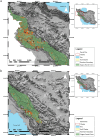Fire protection priorities in the oak forests of Iran with an emphasis on vertebrate habitat preservation
- PMID: 38972910
- PMCID: PMC11228051
- DOI: 10.1038/s41598-024-65355-z
Fire protection priorities in the oak forests of Iran with an emphasis on vertebrate habitat preservation
Abstract
This study examines the impact of fire incidents on wildlife and habitats in the western oak forests of Iran (Zagros region). These forests are globally recognized for their exceptional biodiversity but are frequently threatened by wildfires. To achieve this, the study uses the space-time scan statistics permutation (STSSP) model to identify areas with a higher frequency of fires. The study also analyzes the effects of fires on the Zagros forests from 2000 to 2021 using remote-sensing MODIS data. Also, to understand the elements at risk of fire, burned areas were assessed based on the richness of vertebrate species, determined by the distribution of 88 vertebrate species. The results show that the annual fire rate in the Zagros forests is 76.2 (fire occurrences per year), calculated using the Poisson distribution. Findings show the highest fire rates are found in the northwest and a part of the south of the Zagros. The northwest of the Zagros also has the largest number of single fires and clusters, indicating a wide spatial distribution of fire in these regions. On the other side, it was unexpectedly found that these regions have the richest number of species and higher habitat value. The results demonstrate a significant correlation between the value of the habitat and the extent of burned areas (p < 0.05). The study also reveals that the greatest impact of fires is on small vertebrates. The overlap of frequent fire spots with the richest regions of Zagros oak forests in terms of vertebrate diversity emphasizes the need for strategic forest risk reduction planning, especially in these priority zones.
Keywords: Cluster analysis; Forest fires; Space–time scan statistics permutation model; Vertebrate diversity; Zagros forests.
© 2024. The Author(s).
Conflict of interest statement
The authors declare no competing interests.
Figures






Similar articles
-
Non-parametric spatiotemporal trends in fire: An approach to identify fire regimes variations and predict seasonal effects of fire in Iran.PLoS One. 2025 Apr 4;20(4):e0319993. doi: 10.1371/journal.pone.0319993. eCollection 2025. PLoS One. 2025. PMID: 40184360 Free PMC article.
-
Distribution characteristics of vegetation fires in border areas of China from 2001 to 2022 based on MODIS fire spot data.Ying Yong Sheng Tai Xue Bao. 2024 Nov;35(11):3095-3106. doi: 10.13287/j.1001-9332.202411.020. Ying Yong Sheng Tai Xue Bao. 2024. PMID: 39925066 English.
-
Assessing forest fire dynamics and risk zones in Central Indian forests: a comparative study of the Khandwa and North Betul forest divisions of Madhya Pradesh.Environ Monit Assess. 2024 Aug 14;196(9):810. doi: 10.1007/s10661-024-12960-0. Environ Monit Assess. 2024. PMID: 39141225
-
Reassessment of carbon emissions from fires and a new estimate of net carbon uptake in Russian forests in 2001-2021.Sci Total Environ. 2022 Nov 10;846:157322. doi: 10.1016/j.scitotenv.2022.157322. Epub 2022 Jul 22. Sci Total Environ. 2022. PMID: 35872207 Review.
-
Influences of wildfire on the forest ecosystem and climate change: A comprehensive study.Environ Res. 2024 Jan 1;240(Pt 2):117537. doi: 10.1016/j.envres.2023.117537. Epub 2023 Oct 30. Environ Res. 2024. PMID: 37914016 Review.
Cited by
-
Non-parametric spatiotemporal trends in fire: An approach to identify fire regimes variations and predict seasonal effects of fire in Iran.PLoS One. 2025 Apr 4;20(4):e0319993. doi: 10.1371/journal.pone.0319993. eCollection 2025. PLoS One. 2025. PMID: 40184360 Free PMC article.
References
-
- Horncastle VJ, Chambers CL, Dickson BG. Grazing and wildfire effects on small mammals inhabiting montane meadows. J. Wildl. Manag. 2019;83(3):534–543. doi: 10.1002/jwmg.21635. - DOI
-
- Müller MM, Vilà-Vilardell L, Vacik H. Towards an integrated forest fire danger assessment system for the European Alps. Eco. Inform. 2020;60:101151. doi: 10.1016/j.ecoinf.2020.101151. - DOI
-
- Connell J, et al. Fire, drought and flooding rains: The effect of climatic extremes on bird species’ responses to time since fire. Divers. Distrib. 2022;28(3):417–438. doi: 10.1111/ddi.13287. - DOI
MeSH terms
LinkOut - more resources
Full Text Sources
Medical

